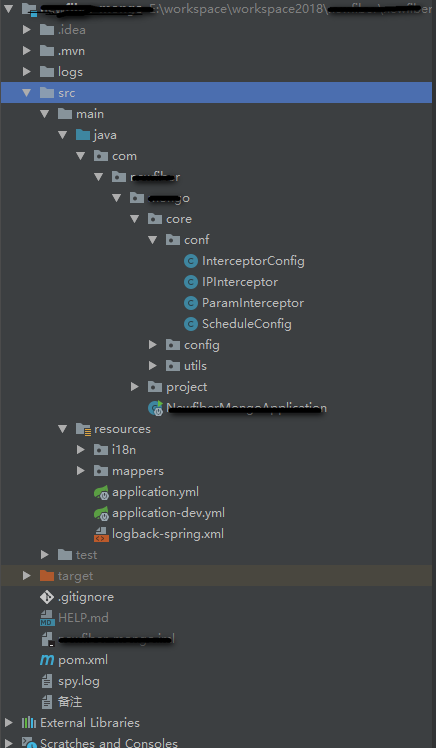springboot 学习之路 27(实现ip白名单功能)
背景:
最近项目中遇到关于对部分请求设置ip白名单的功能需求,在这简单梳理一下我的开发步骤与思路
实践步骤:
思路: 关于实现ip白名单的过滤我大致会想到三种实现方式:
- 对相关需要过滤的控制类进行单独设置 -------------- 代码臃肿,不利于维护
- 利用相关拦截器进行统一实现 --------------相对好实现 -----------我就以这种方法做介绍
- 前后端分离,让前端控制ip请求 --------------你要是和前端关系好的话可以试试
第一步:
把相关的环境准备好,我这边已经有现成的项目,我就在现成的项目进行演示,对其中涉及到保密的东西我会注释掉,仅限参考

大致的项目架构就是这样,我主要在config包中进行相关拦截器的开发工作。
先准备相关的拦截器:
/** * @author : HUHY http://www.cnblogs.com/huhongy/ * @Project_name:xxxxxxx * @date:2020/1/14 9:46 * @email:hhy_0602@163.com * @description:{todo} */ @Slf4j public class IPInterceptor implements HandlerInterceptor { @Autowired private ProjectTableDao projectTableDao; @Override public boolean preHandle(HttpServletRequest request, HttpServletResponse response, Object handler) throws Exception { log.info("---------- 判断相关ip"); //先获取相关需要验证的ip列表 //过滤ip,若用户在白名单内,则放行 String ipAddress=IPUtils.getRealIP(request); //所用需要验证的ip,暂时批量验证 List<String> listIps = getListIps(); if (listIps == null || listIps.size() == 0 || !listIps.contains(ipAddress) ){ response.getWriter().print("请检查ip白名单配置是否正确"); return false; } return true; } @Override public void postHandle(HttpServletRequest request, HttpServletResponse response, Object handler, ModelAndView modelAndView) throws Exception { } @Override public void afterCompletion(HttpServletRequest request, HttpServletResponse response, Object handler, Exception ex) throws Exception { } /** * 获取符合要求的项目 * @return */ public List<String> getListIps(){ /** * 保存最后结果 */ List<String> result = new ArrayList<>(); Map<String,Object> map = new HashMap<>(); map.put("flag","1"); map.put("enabled","1"); List<ProjectTable> projectTables = projectTableDao.selectByMap(map); /** * @author: huhy http://www.cnblogs.com/huhongy/ */ for (ProjectTable projectTable : projectTables) { String ips = projectTable.getIps(); List<String> list = splitStr(ips); result.addAll(list); } return result; } /** * 吧ip拆分 */ public List<String> splitStr(String ips){ List<String> temp = new ArrayList<>(); String[] split = ips.split(","); List<String> list = Arrays.asList(split); /** * @author: huhy http://www.cnblogs.com/huhongy/ */ for (String s : list) { temp.add(s); } return temp; } }
关于防止代理ip,获取多ip的首位ip
public class IPUtils {
/**
* 获取用户真实IP地址,不使用request.getRemoteAddr()的原因是有可能用户使用了代理软件方式避免真实IP地址,
* 可是,如果通过了多级反向代理的话,X-Forwarded-For的值并不止一个,而是一串IP值
* @return ip
*/
public static String getRealIP(HttpServletRequest request) {
String ip = request.getHeader("x-forwarded-for");
if (ip != null && ip.length() != 0 && !"unknown".equalsIgnoreCase(ip)) {
// 多次反向代理后会有多个ip值,第一个ip才是真实ip
if( ip.indexOf(",")!=-1 ){
ip = ip.split(",")[0];
}
}
if (ip == null || ip.length() == 0 || "unknown".equalsIgnoreCase(ip)) {
ip = request.getHeader("Proxy-Client-IP");
System.out.println("Proxy-Client-IP ip: " + ip);
}
if (ip == null || ip.length() == 0 || "unknown".equalsIgnoreCase(ip)) {
ip = request.getHeader("WL-Proxy-Client-IP");
System.out.println("WL-Proxy-Client-IP ip: " + ip);
}
if (ip == null || ip.length() == 0 || "unknown".equalsIgnoreCase(ip)) {
ip = request.getHeader("HTTP_CLIENT_IP");
System.out.println("HTTP_CLIENT_IP ip: " + ip);
}
if (ip == null || ip.length() == 0 || "unknown".equalsIgnoreCase(ip)) {
ip = request.getHeader("HTTP_X_FORWARDED_FOR");
System.out.println("HTTP_X_FORWARDED_FOR ip: " + ip);
}
if (ip == null || ip.length() == 0 || "unknown".equalsIgnoreCase(ip)) {
ip = request.getHeader("X-Real-IP");
System.out.println("X-Real-IP ip: " + ip);
}
if (ip == null || ip.length() == 0 || "unknown".equalsIgnoreCase(ip)) {
ip = request.getRemoteAddr();
System.out.println("getRemoteAddr ip: " + ip);
}
return ip;
}
}
最后一步,注册拦截器即可:
@Configuration
public class InterceptorConfig implements WebMvcConfigurer {
@Override
public void addInterceptors(InterceptorRegistry registry) {
registry.addInterceptor(new ParamInterceptor()).addPathPatterns("/data/wuc/**");
/**
* 指定拦截的相关请求接口
*/
//registry.addInterceptor(new ParamInterceptor()).addPathPatterns("/data/wuc/**");
}
}
到这,关于ip白名单的功能就完成了。有兴趣的可以试一下
本文来自博客园,作者:huhy,转载请注明原文链接:https://www.cnblogs.com/huhongy/p/12192310.html


